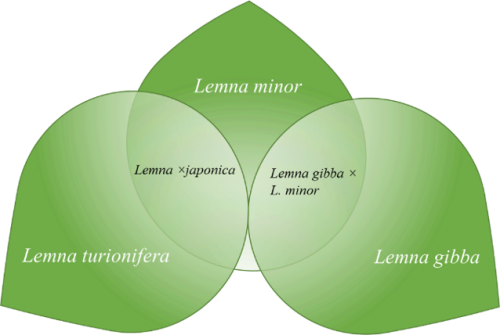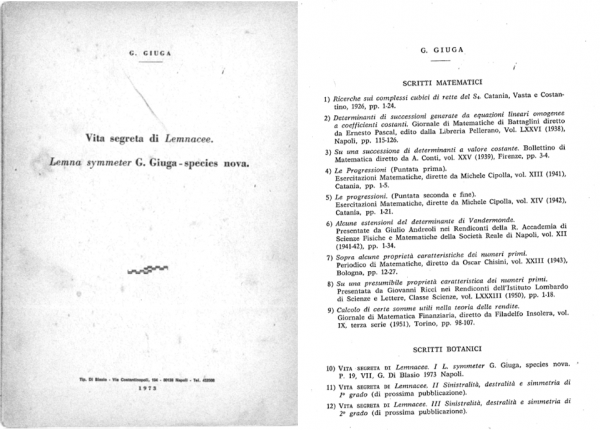
In a previous issue of this blog it was shown how duckweed can become a new important resource for the agrifood sector, due to its high protein content for feed and food, water phytoremediation and energy production from accumulated starch.
Duckweed is not a single species, rather a family including 36 different species, some highly similar by morphology and difficult to be taken apart, but different for their physiologic, biochemical and ecological features, making them suitable to different applications.
During the genetic characterization of the IBBA duckweed collection, recently enriched with clones from the Landolt Duckweed Collection, we got two important results in the molecular taxonomy of the family. In fact, two different interspecific hybrids were discovered. Hybridization between two closely related species is not unusual in plants, when efficient reproductive barriers have not been developed. More unusual is the fact that such hybridization occurred in plants mainly reproducing asexually and commonly thought to flower rarely.
The first hybrid corresponds to a species known as Lemna japonica, often mistaken for the morphologically similar Lemna minor, from which it can be hardly taken apart even when using the DNA barcoding techniques. However, we have been able to elucidate the genetic structure of this species by using a simple and rapid fingerprinting protocol (TBP) developed in our laboratory, which targets nuclear genes and does not require DNA sequencing,
Lemna x japonica, as it should be more correctly named, turned out to be a hybrid between Lemna minor and Lemna turionifera. The failure of the classic barcoding technology in separating the two species is due to the fact that target sequences (markers) are of plastid origin, and therefore maternally inherited, as mitochondria. For this reason, plastid DNA of Lemna x japonica is indistinguishable from that of the maternal parent, Lemna minor. The new taxonomic revision contributed to highlight a high number of clone misclassifications, based on morphology or barcoding analysis, as well as to redefine the geographic distribution of the species, not limited to Eastern Asia as previously thought.
The second case is instead related to the discovery of a new cryptic species, indistinguishable from Lemna gibba by morphology, but also in this case turning out to be an interspecific hybrid by genetic analysis. We have identified six different clones belonging to this species in the IBBA collection, all from Mediterranean origin (Italy, Egypt, Israel) and recorded as Lemna gibba. However, in some old publications of the 70ies, a species closely related to Lemna gibba but less gibbous (the name derives from the ventral swelling on the frond) was mentioned under the name of Lemna symmeter, a species described in Southern Italy by Giuseppe Giuga in 1973. The name of the new species was not regarded as valid since the Latin description, required at the time according to the taxonomic rules, was missing, and the species was never observed thereafter.
We thought that the newly discovered hybrid could correspond to this neglected species but we needed the original description to verify this hypothesis. However, the short monograph, entitled “The secret life of Lemnaceaea. Lemna symmeter G. Giuga–species nova” published in Naples, in Italian, was not retrievable from any scientific journal online repository. We were completely unsuccessful also contacting the libraries of the University and the Botanical Gardens of Naples. We couldn’t found either any other publication by this Author, or information about its affiliation.
However, luck smiled at us when we found a copy of the monograph from a second-hand bookseller in Naples through the e-bay website, for 10 €. The description, including photos and drawings by the Author, suggests that the populations found in different places of the Campania region, and differing from L. gibba for flower development and sterility, belong to “our” hybrid species. Flower induction is ongoing to verify this possibility. The mystery about the identity of the Author of the monograph, unknown as a botanist, was solved on the last page of the booklet, listing the recent publications by G. Giuga, which were all mathematical writings, besides two further publications about symmetry in duckweed development, to be published. Further investigation revealed that Giuseppe Giuga wasn’t a botanist, rather a Neapolitan mathematician, known for his work on prime numbers reported as the so-called “Giuga’s conjecture”, published in 1950. The Giuga numbers are therefore those prime numbers fulfilling the requirements of his conjecture on primality. His passion for duckweeds and a keen spirit of observation induced this mathematic scholar to delve into botany as an amateur to the point of trying his hand with the description of a new plant species. This short note and the forthcoming description of the new hybrid species are a tribute to acknowledge this Italian scientist and the interdisciplinarity of science.

Author: Laura Morello